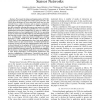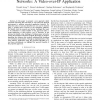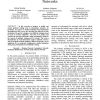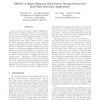SECON
2008
IEEE
14 years 7 months ago
2008
IEEE
— Previous results show that a node’s throughput scales poorly as the network size increases when every node has traffic. However, in many cases, only a fraction of nodes in l...
SECON
2008
IEEE
14 years 7 months ago
2008
IEEE
Abstract—In contrast to existing work on the connected coverage problem in wireless sensor networks which assumes omnidirectional sensors with disk-like sensing range, this paper...
SECON
2008
IEEE
14 years 7 months ago
2008
IEEE
—We present the design and implementation of UDAE, a Universal Data Access Engine for wireless sensor networks. The UDAE allows developers to access data both locally and over th...
SECON
2008
IEEE
14 years 7 months ago
2008
IEEE
—In this paper we present a new approach called cue-based networking that uses hints or cues about the physical environment to optimize networked application behavior. We define...
SECON
2008
IEEE
14 years 7 months ago
2008
IEEE
– In this research, we propose to modify and extend epidemic routing used in intermittent networks. In particular, we propose to include immunity-based information disseminated i...
SECON
2008
IEEE
14 years 7 months ago
2008
IEEE
—We present a new routing metric for multi-rate multi-radio mesh networks, which takes into account both contention for the shared wireless channel and rate diversity in multi-ra...
SECON
2008
IEEE
14 years 7 months ago
2008
IEEE
Sensor networks will shortly consist of globally deployed sensors providing real-time geo-centric information to users. Particularly, users with mobile devices will issue ad-hoc q...
SECON
2008
IEEE
14 years 7 months ago
2008
IEEE
Abstract—In this paper, we propose and evaluate two distributed protocols for finding low-cost broadcast and multicast trees in wireless networks. The constructed trees can then...
SECON
2008
IEEE
14 years 7 months ago
2008
IEEE
—The novel cross-layer protocol Breath for wireless sensor networks is designed, implemented, and experimentally evaluated. The Breath protocol is based on randomized routing, MA...
SECON
2008
IEEE
14 years 7 months ago
2008
IEEE
In 2003, the MIT Technology Review magazine listed wireless sensor networks as one of “Ten Emerging Technologies That Will Change the World” [2]. Five years later, are wireles...




